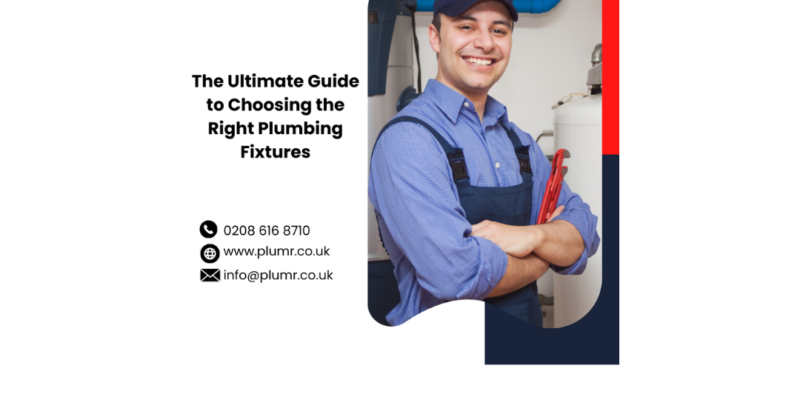
Introduction
Plumbing fixtures play a crucial role in both the functionality and aesthetics of a home’s plumbing system. Selecting the right fixtures, from the kitchen sink to the bathroom faucets and showerheads, involves style, material, water efficiency, and budget considerations. This comprehensive guide aims to equip homeowners with the knowledge to make informed decisions when choosing plumbing service, ensuring they enhance their living spaces’ practicality and visual appeal.
Understanding Different Types of Plumbing Fixtures
Bathroom Fixtures
Bathroom fixtures encompass a variety of essentials:
- Sinks: Available in diverse styles, from pedestal to undermount, sinks depend on space and aesthetic preferences.
- Faucets: Options range from traditional two-handle designs to modern single-handle models, each offering different functionalities and styles.
- Toilets: Consider flushing mechanisms, water efficiency (gallons per flush), and comfort height options.
- Bathtubs: Choices include freestanding, alcove, and drop-in tubs, with considerations for space and relaxation features.
- Showers: Choose between showerheads, handhelds, and multifunctional systems, focusing on water pressure and spray options.
Kitchen Fixtures
Key kitchen fixtures include:
- Sinks: Stainless steel and composite materials are famous for durability and aesthetics, with considerations for size, bowl depth, and accessories like integrated cutting boards.
- Faucets: Options range from pull-down sprayers to touchless technology, focusing on ease of use and water conservation.
- Disposals: Consider horsepower and noise reduction features.
- Dishwashers: Choose based on energy efficiency ratings and capacity.
Utility Room Fixtures
Utility room essentials may include:
- Utility Sinks: Material choices like stainless steel or moulded plastic, with features like deep basins and built-in drying racks.
- Laundry Faucets: Focus on durability and ease of use for washing tasks.
Material and Finish Options
Common Materials
- Stainless Steel: Known for durability and resistance to corrosion.
- Brass: Offers a classic look with excellent longevity.
- Bronze: Provides a rustic appearance and durability.
- Copper: Known for its antimicrobial properties and aesthetic appeal.
- Porcelain: Offers a classic, glossy finish suitable for traditional settings.
Finish Options
- Chrome: Versatile and easy to clean, suitable for modern and traditional settings.
- Brushed Nickel: Resist fingerprints and water spots, ideal for contemporary bathrooms.
- Oil-Rubbed Bronze: Provides an antique look with low maintenance.
- Matte Black: Offers a modern, sleek appearance with stain resistance.
- Polished Brass: Provides a warm, luxurious look, though it may require more maintenance.
Style and Design Considerations
- Traditional vs. Modern Fixtures: Consider the overall theme of your home when choosing between classic or contemporary styles.
- Matching Fixtures with Home Décor: Coordinate colours and finishes with existing cabinetry, countertops, and hardware.
- Ergonomic and Functional Design Features: Prioritize ease of use, such as lever handles for accessibility or touchless technology for convenience.
- Innovative and Smart Fixtures: Explore options like brilliant faucets with temperature control or motion-activated sensors for water conservation.
Water Efficiency and Sustainability
- Low-Flow Fixtures: Save water and reduce utility bills with fixtures that meet WaterSense® standards.
- Benefits of Water Conservation: Discuss the environmental and financial benefits of choosing water-efficient fixtures.
- Eco-Friendly Materials: Opt for fixtures made from sustainable materials like recycled metals or biodegradable plastics.
- Certifications and Standards: Look for products certified by organizations like WaterSense® or LEED® for environmental performance.
Budget and Cost Considerations
- Setting a Budget: Determine a budget range based on your overall project and prioritize essential fixtures.
- Cost of Different Types of Fixtures: Compare basic, mid-range, and luxury options.
- Balancing Quality and Affordability: Invest in durable fixtures that offer long-term value and performance.
- Long-Term Cost Savings: Consider energy-efficient and water-saving fixtures that reduce utility bills over time.
Installation and Maintenance
- DIY vs. Professional Installation: Evaluate installation complexity and safety considerations before deciding whether to DIY or hire a professional.
- Essential Maintenance Tips: Guide cleaning and upkeep to extend the lifespan of fixtures.
- Troubleshooting: Address common problems such as leaky faucets or clogged drains and provide troubleshooting tips.
- Warranty and Support: Review warranty coverage and after-sales support offered by manufacturers.
Popular Brands and Manufacturers
- High-End Luxury Brands: Highlight prestigious brands known for quality craftsmanship and innovative designs.
- Affordable and Reliable Brands: Recommend reputable brands offering reliable performance at various prices.
- Comparative Analysis of Top Brands: Compare factors like warranty, customer service, and product variety among leading brands.
Conclusion
Choosing the right plumbing fixtures involves careful consideration of functionality, style, sustainability, and budget. By understanding the different fixtures, materials, and design options available, homeowners can make informed decisions that enhance their homes’ efficiency and aesthetics. Whether upgrading a bathroom or renovating a kitchen, prioritizing quality and compatibility with existing décor ensures long-term satisfaction and value.
FAQs:
1. What are the most durable materials for plumbing fixtures?
Answer: Stainless steel, brass, and porcelain are the most durable materials for plumbing fixtures. These materials are resistant to corrosion and wear, ensuring longevity and durability in your home.
2. How can I ensure my fixtures are water-efficient?
Answer: Look for fixtures certified by programs like WaterSense, indicating they meet strict water efficiency and performance criteria. Opting for low-flow faucets, showerheads, and toilets can significantly reduce water consumption without sacrificing performance.
3. What should I consider when choosing a fixture style?
Answer:
- Consider the overall style of your home and personal preferences.
- Choose fixtures that complement your existing décor, whether you prefer traditional, modern, or eclectic designs.
- Pay attention to finishes and shapes that harmonize with your space.
4. Are there any fixtures that are easier to maintain?
Answer: Fixtures with smooth, non-porous surfaces such as chrome or brushed nickel finishes are easier to clean and maintain. Additionally, opting for fixtures with fewer intricate details can simplify maintenance tasks.
5. How do I match my fixtures with my existing home décor?
Answer:
- Coordinate finishes and styles with existing cabinetry, countertops, and hardware.
- Choose fixtures that compliment the colour scheme and overall aesthetic of your home.
- Consider bringing samples or swatches to compare colours and finishes before deciding.










